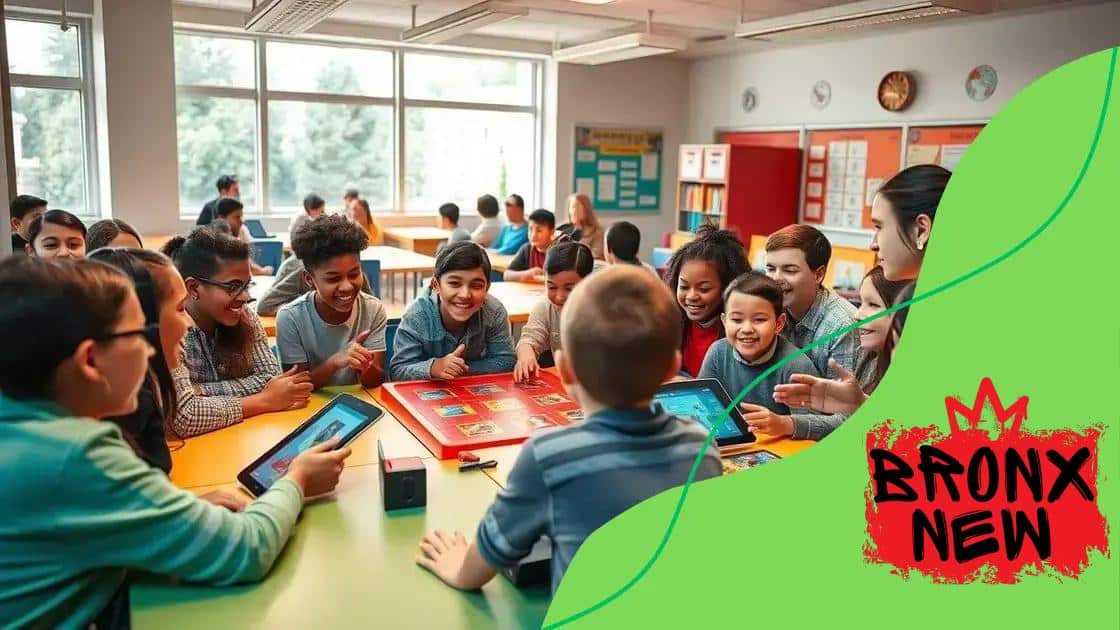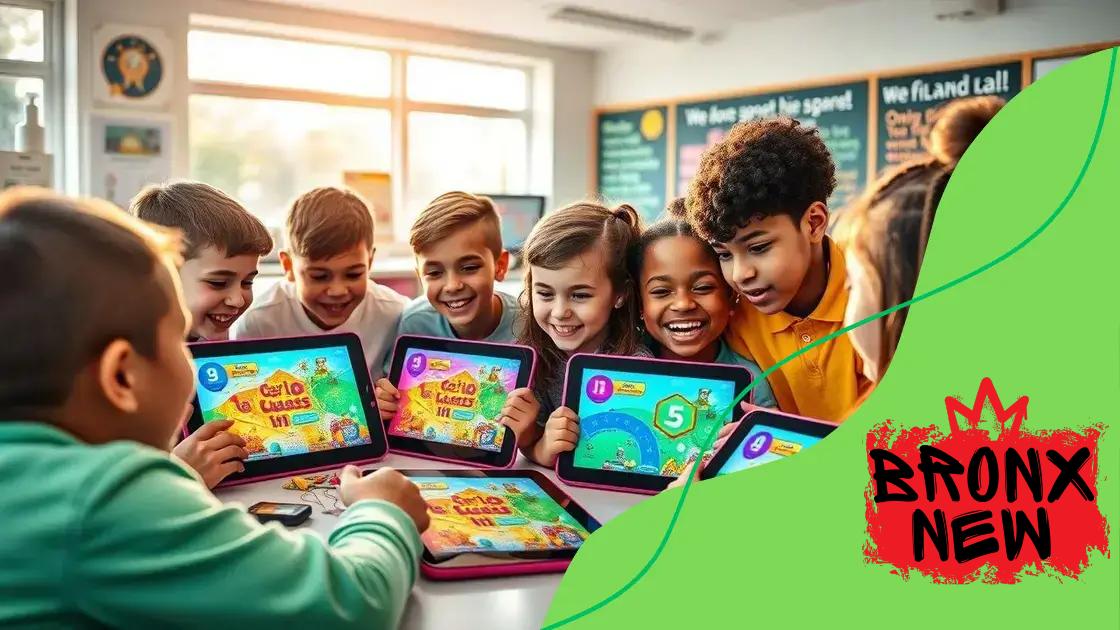Gamification in K-12 education: engaging students more effectively

Gamification in K-12 education enhances student engagement and learning by integrating game elements such as rewards and challenges, while promoting teamwork and personalized experiences through innovative technology.
Gamification in K-12 education has emerged as a powerful strategy to captivate students and make learning more enjoyable. Have you ever considered how game-like elements could transform the classroom experience? Let’s dive into this exciting approach.
Understanding gamification in education
Understanding gamification in education is essential for creating an engaging learning environment. This approach incorporates game-like elements into the classroom, making lessons more interactive and entertaining. Teachers can harness these elements to motivate students and enhance their learning journey.
Key components of gamification
Several elements contribute to effective gamification. These elements can vary widely based on the subject matter and grade level. However, some core components include:
- Points: Students earn points for completing tasks or challenges, encouraging progress and effort.
- Badges: Badges reward specific accomplishments, helping students feel recognized for their achievements.
- Leaderboards: Friendly competition through leaderboards can motivate students to improve their skills.
- Levels: Progression through levels makes learning feel like an adventure, where each level uncovers new knowledge.
These elements not only enhance motivation but also change the perception of learning. Instead of viewing tasks as chores, students begin to see them as challenges to conquer. This transformation can lead to increased participation and excitement in the classroom. By integrating gamification, educators can create an environment where students are eager to engage.
How it works in practice
Implementing gamification in educational settings requires thoughtful planning. Teachers should consider their learning objectives and how each game element can support those goals. A well-designed gamified lesson might include a point system that rewards students for collaboration in group projects. Additionally, incorporating challenges that require critical thinking can stimulate deeper learning.
As students engage with these game mechanics, they develop important skills such as teamwork, communication, and problem-solving. They also become more resilient, as they learn to navigate failures and try again. Overall, understanding the foundations of gamification in education can empower educators to design effective, motivating lessons.
Benefits of gamification for students
The benefits of gamification for students are numerous and impactful. By incorporating game elements into learning, students become more engaged and motivated. This method enhances their desire to participate actively in classroom activities, transforming their educational experience.
Enhanced Engagement
Gamification boosts student engagement significantly. When students earn points or badges, they feel a sense of achievement. This can lead to a more enthusiastic approach to learning, as they are eager to meet challenges.
- Competitive spirit: Friendly competition can ignite enthusiasm, encouraging students to strive for better performance.
- Interactive learning: Game-based tasks require interaction, making the learning process exciting and dynamic.
- Immediate feedback: Gamification provides real-time feedback, allowing students to understand their progress instantly.
Moreover, this innovative approach can cater to different learning styles. For instance, some students thrive in visual and interactive environments, while others may prefer strategic thinking that comes with game challenges. The diversity in gamified elements can address these varied preferences and encourage a richer learning experience.
Development of Critical Skills
Another major benefit of gamification is the development of essential skills. Students learn to work collaboratively in team-based challenges, developing their communication and social skills. They also build resilience as they confront obstacles and learn to adapt their strategies.
These skills are vital not only in academic settings but also in future workplaces. By engaging in gamified learning, students grow as problem solvers and critical thinkers. They learn to analyze situations and make decisions quickly, competencies that are valuable in today’s fast-paced world.
In addition to fostering skills, gamification can improve retention of information. Game mechanics can help reinforce lessons in a memorable way. When students enjoy the learning process, they are more likely to remember the material.
Practical examples of gamification in K-12

There are many practical examples of gamification in K-12 education that demonstrate how this approach can enhance learning experiences. Educators worldwide are using game elements in various subjects, creating engaging lessons that capture students’ attention.
Classroom Challenges and Quests
One effective method is incorporating challenges or quests into the curriculum. For instance, a teacher might create a math quest where students work in teams to solve problems to earn points or unlock new levels of difficulty. This setup fosters teamwork and critical thinking.
- Project-based learning: Students can undertake projects that require them to research and present information as part of a game.
- Role-playing games: In history classes, role-playing can transport students to different times and places, encouraging them to explore historical events creatively.
- Scavenger hunts: Teachers can organize scavenger hunts using clues related to the subject material, promoting exploration and collaboration.
These gamified activities not only motivate students but also emphasize the importance of collaboration and communication among peers. The excitement of completing a quest or challenge often leads to a deeper understanding of the material.
Digital Tools and Platforms
In addition to physical games, many educators utilize digital tools to implement gamification. Online learning platforms like Kahoot! or Quizizz allow teachers to create interactive quizzes that students can answer in real-time. This approach makes assessments feel more like a game.
Another example is using apps that simulate real-world scenarios. For example, students can use budgeting apps to apply math skills in financial literacy games. Such tools help bridge the gap between theoretical knowledge and practical application.
As students navigate these digital landscapes, they become more engaged with the content, improving both their motivation and retention of information. Overall, these practical examples illustrate how gamification can transform the learning experience in K-12 settings.
Challenges of implementing gamification
Implementing gamification in education comes with several challenges that educators need to address. While the concept is exciting and offers numerous benefits, effectively integrating game elements into the classroom is not always straightforward.
Resistance to Change
One major hurdle is resistance from both teachers and students. Some educators may feel uncertain about using new technology or restructuring their teaching methods. On the other hand, students might be hesitant to adapt to game-based learning if they have been accustomed to traditional methods.
- Training needs: Teachers often require training to understand how to implement gamification effectively, which can be time-consuming.
- Student buy-in: Gaining student enthusiasm for gamified methods can take time and patience.
- Curriculum alignment: Ensuring that gamified activities align with learning objectives is vital for effectiveness.
Moreover, integrating gamification into the existing curriculum necessitates a thoughtful approach. In some cases, educators may need to overhaul their lesson plans to create engaging activities that are both educational and fun.
Resource Limitations
Another challenge is the availability of resources. Not all schools have equal access to the technology needed for gamification. This gap can lead to disparities in learning experiences among students.
Many gamified learning tools require devices and internet access, which may not be feasible in every classroom. Educators need to find creative solutions that can engage students without requiring the latest technology.
In addition, the time required to develop, implement, and evaluate gamified activities can be daunting. Teachers often juggle multiple responsibilities, making it challenging to invest the necessary time to design engaging lessons.
Addressing these challenges is essential for successfully integrating gamification into K-12 education. By providing training, ensuring access to resources, and fostering a supportive environment, educators can overcome these obstacles and harness the power of gamification for improved student engagement.
Future trends in gamification for education
The future trends in gamification for education promise to reshape the way students learn and engage with content. As technology continues to evolve, so does the potential for new and innovative gamified learning experiences.
Increased Use of Augmented and Virtual Reality
One exciting trend is the integration of augmented reality (AR) and virtual reality (VR) into gamified learning. These technologies create immersive environments that allow students to experience lessons in a hands-on way. For example, students can explore ancient civilizations through VR simulations or conduct science experiments in a virtual lab.
- Immersive learning: AR and VR provide realistic scenarios that enhance understanding.
- Interactive elements: These technologies allow for real-time interaction, making lessons more engaging.
- Accessibility: Students can access experiences that may not be possible in a traditional classroom setting.
As more schools adopt these technologies, we can expect to see a more dynamic approach to gamification that leverages these tools for deeper learning.
Personalized Learning Experiences
Another trend is the focus on personalized learning through gamification. Educational platforms will increasingly use data analytics to tailor experiences based on individual student performance and preferences. This approach ensures that each student can learn at their own pace and in their preferred style.
For instance, a gamified system might adjust challenges based on how a student is performing, providing additional practice in areas where they struggle. This individualized approach not only improves learning outcomes but also keeps students motivated and engaged.
Collaboration and Social Learning
The future of gamification also emphasizes collaboration and social learning. Game mechanics that encourage teamwork, such as group quests or challenges, are becoming more prevalent. This design fosters community among students and enhances critical social skills.
In an increasingly interconnected world, the ability to collaborate effectively is essential. Gamified learning environments that promote group work help prepare students for real-world situations where teamwork is key.
Overall, the integration of these future trends in gamification for education will likely lead to more engaging, personalized, and collaborative learning experiences for students. As technology advances, educators will have even more tools to create effective gamified environments that nurture student growth and enthusiasm for learning.
FAQ – Frequently Asked Questions about Gamification in K-12 Education
What are the main benefits of gamification in education?
Gamification enhances student engagement, motivation, and learning outcomes by making lessons more interactive and enjoyable.
How can technology, like AR and VR, be used in gamification?
Augmented and virtual reality create immersive learning experiences that allow students to explore subjects in hands-on ways, increasing their understanding and interest.
What challenges might educators face when implementing gamification?
Some educators may resist changing their teaching methods, and resource limitations can hinder the effective use of gamified learning tools.
How does gamification promote collaboration among students?
Gamified activities often involve teamwork and group challenges, which help students develop crucial social skills and learn to work effectively with others.





